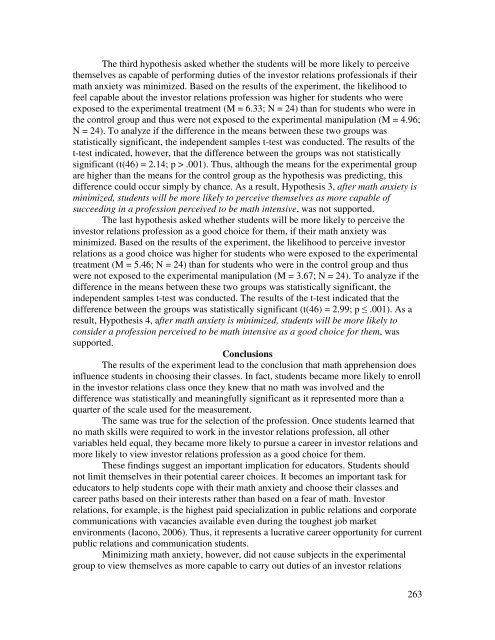2010 - Public Relations Society of America
2010 - Public Relations Society of America
2010 - Public Relations Society of America
Create successful ePaper yourself
Turn your PDF publications into a flip-book with our unique Google optimized e-Paper software.
The third hypothesis asked whether the students will be more likely to perceive<br />
themselves as capable <strong>of</strong> performing duties <strong>of</strong> the investor relations pr<strong>of</strong>essionals if their<br />
math anxiety was minimized. Based on the results <strong>of</strong> the experiment, the likelihood to<br />
feel capable about the investor relations pr<strong>of</strong>ession was higher for students who were<br />
exposed to the experimental treatment (M = 6.33; N = 24) than for students who were in<br />
the control group and thus were not exposed to the experimental manipulation (M = 4.96;<br />
N = 24). To analyze if the difference in the means between these two groups was<br />
statistically significant, the independent samples t-test was conducted. The results <strong>of</strong> the<br />
t-test indicated, however, that the difference between the groups was not statistically<br />
significant (t(46) = 2.14; p > .001). Thus, although the means for the experimental group<br />
are higher than the means for the control group as the hypothesis was predicting, this<br />
difference could occur simply by chance. As a result, Hypothesis 3, after math anxiety is<br />
minimized, students will be more likely to perceive themselves as more capable <strong>of</strong><br />
succeeding in a pr<strong>of</strong>ession perceived to be math intensive, was not supported.<br />
The last hypothesis asked whether students will be more likely to perceive the<br />
investor relations pr<strong>of</strong>ession as a good choice for them, if their math anxiety was<br />
minimized. Based on the results <strong>of</strong> the experiment, the likelihood to perceive investor<br />
relations as a good choice was higher for students who were exposed to the experimental<br />
treatment (M = 5.46; N = 24) than for students who were in the control group and thus<br />
were not exposed to the experimental manipulation (M = 3.67; N = 24). To analyze if the<br />
difference in the means between these two groups was statistically significant, the<br />
independent samples t-test was conducted. The results <strong>of</strong> the t-test indicated that the<br />
difference between the groups was statistically significant (t(46) = 2.99; p ≤ .001). As a<br />
result, Hypothesis 4, after math anxiety is minimized, students will be more likely to<br />
consider a pr<strong>of</strong>ession perceived to be math intensive as a good choice for them, was<br />
supported.<br />
Conclusions<br />
The results <strong>of</strong> the experiment lead to the conclusion that math apprehension does<br />
influence students in choosing their classes. In fact, students became more likely to enroll<br />
in the investor relations class once they knew that no math was involved and the<br />
difference was statistically and meaningfully significant as it represented more than a<br />
quarter <strong>of</strong> the scale used for the measurement.<br />
The same was true for the selection <strong>of</strong> the pr<strong>of</strong>ession. Once students learned that<br />
no math skills were required to work in the investor relations pr<strong>of</strong>ession, all other<br />
variables held equal, they became more likely to pursue a career in investor relations and<br />
more likely to view investor relations pr<strong>of</strong>ession as a good choice for them.<br />
These findings suggest an important implication for educators. Students should<br />
not limit themselves in their potential career choices. It becomes an important task for<br />
educators to help students cope with their math anxiety and choose their classes and<br />
career paths based on their interests rather than based on a fear <strong>of</strong> math. Investor<br />
relations, for example, is the highest paid specialization in public relations and corporate<br />
communications with vacancies available even during the toughest job market<br />
environments (Iacono, 2006). Thus, it represents a lucrative career opportunity for current<br />
public relations and communication students.<br />
Minimizing math anxiety, however, did not cause subjects in the experimental<br />
group to view themselves as more capable to carry out duties <strong>of</strong> an investor relations<br />
263
















